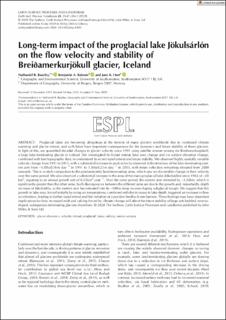| dc.description.abstract | Proglacial lakes are becoming ubiquitous at the termini of many glaciers worldwide due to continued climate warming and glacier retreat, and such lakes have important consequences for the dynamics and future stability of these glaciers. In light of this, we quantified decadal changes in glacier velocity since 1991 using satellite remote sensing for Breiðamerkurjökull, a large lake‐terminating glacier in Iceland. We investigated its frontal retreat, lake area change and ice surface elevation change, combined with bed topography data, to understand its recent rapid retreat and future stability. We observed highly spatially variable velocity change from 1991 to 2015, with a substantial increase in peak velocity observed at the terminus of the lake‐terminating eastern arm from ~1.00 ± 0.36 m day−1 in 1991 to 3.50 ± 0.25 m day−1 in 2015, with mean velocities remaining elevated from 2008 onwards. This is in stark comparison to the predominately land‐terminating arms, which saw no discernible change in their velocity over the same period. We also observed a substantial increase in the area of the main proglacial lake (Jökulsárlón) since 1982 of ~20 km2, equating to an annual growth rate of 0.55 km2 year−1. Over the same period, the eastern arm retreated by ~3.50 km, which is significantly greater than the other arms. Such discrepancies between the different arms are due to the growth and, importantly, depth increase of Jökulsárlón, as the eastern arm has retreated into its ~300 m‐deep reverse‐sloping subglacial trough. We suggest that this growth in lake area, forced initially by rising air temperatures, combined with the increase in lake depth, triggered an increase in flow acceleration, leading to further rapid retreat and the initiation of a positive feedback mechanism. These findings may have important implications for how increased melt and calving forced by climate change will affect the future stability of large soft‐bedded, reverse‐sloped, subaqueous‐terminating glaciers elsewhere. | en_US |

